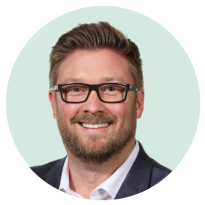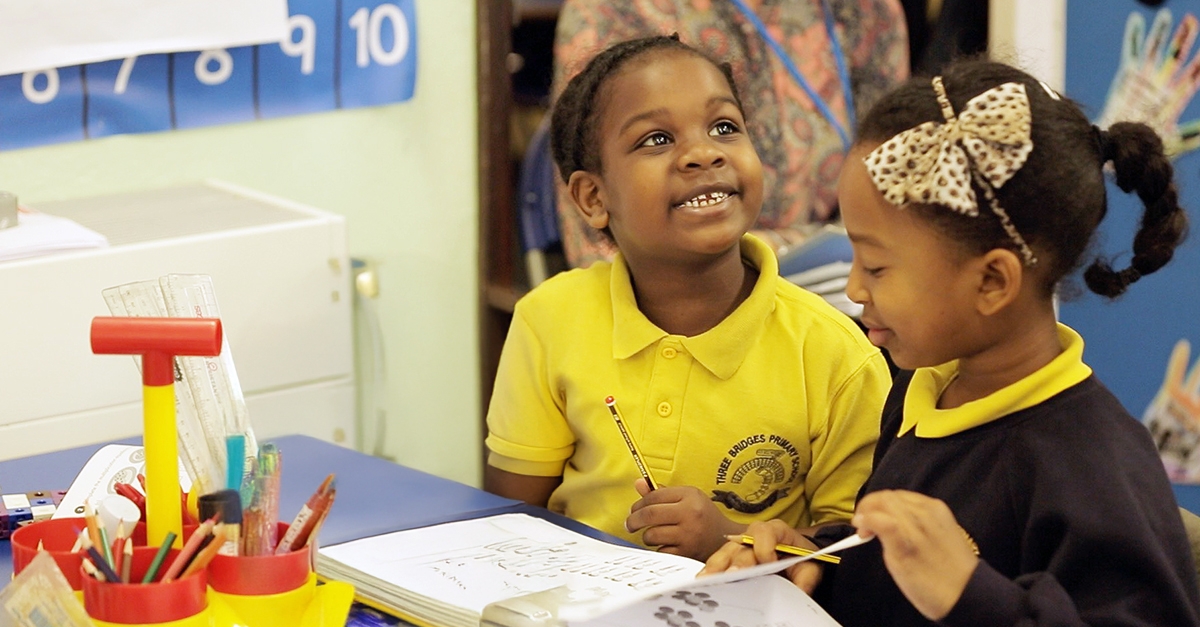Jeremy Hannay’s joyful revolution in primary maths
Editor's note: Dr Hannay's story is part of a broader series of case studies on UK schools and professionals who, through consistent practice and persistent application, have seen dramatic results using our programme. Learn more about our Accredited Schools programme to find a school near you using Maths — No Problem!
Cleverness became about something new; it became about collaboration and problem-solving rather than finishing quickly and getting the right answer.

Dr Jeremy Hannay, executive principal at Three Bridges Primary in Ealing, recalls a classroom exercise from his childhood that exemplifies everything wrong with teaching and learning mathematics.
Challenging the status quo
The goal of the exercise — called “the Mad Minute” — was for students to complete as many questions as possible within 60 seconds.
“You had one minute to fill in as many questions as you could and then the guy next to you got to mark it,” Hannay said during an interview. “And then you had to stand up in front of everybody and tell them how many you got out of 25. It was absolutely shocking educational practice.”
But, he laments, in many ways, things haven’t changed.
For generations, the focus has been on speed, accuracy and arriving at the correct answer as quickly as possible. This approach is a high-pressure, often demoralizing experience. Hannay remembers how this practice created a joyless, uninspiring learning environment, one which he feared existed at Three Bridges when he arrived in 2012.
“When you walked into the classrooms, it wasn't inspirational. It wasn't motivational. It was like learning Latin verbs,” he said.
But Hannay and his staff refused to accept the status quo. They knew they needed to do something different, especially with a student body where more than 60% of pupils don’t have English as a first language and a third are eligible for free school meals. The traditional methods simply weren’t working. The school was determined to move away from a school system where children were just “getting by” and toward a model that nurtured a genuine love for learning.
A better way to teach mathematics
The solution came from an unlikely place: a new approach to teaching mathematics called Maths — No Problem! which draws on an internationally acclaimed Singaporean teaching model. This shift wasn't just about new textbooks; it was about fundamentally changing how students and teachers interact with the subject. The programme places a strong emphasis on collaboration and problem-solving, redefining what it means to be “clever.” Instead of celebrating a single correct answer, students are taught to find joy in exploring different methods, representing problems in new ways and working with others.
“Cleverness became about something new; it became about collaboration and problem-solving rather than finishing quickly and getting the right answer,” Hannay said.
The results of this transformation are nothing short of remarkable. In an elementary school where over half of the children didn't speak English as a first language, 90% of them achieved the expected standard in mathematics, well above the national average. At the same time, 52% of students achieved greater depth in their understanding. In the 2023 multiplication check, 69% of Year 4 pupils achieved a perfect score, compared with 29% nationally.
More than just maths
Hannay says the shift to this new approach was a powerful catalyst that ultimately changed how the school teaches every subject, from history to science, proving that when you get one thing right, the rest can follow.
The school’s remarkable achievement wasn't a quick fix or a simple matter of adopting a new curriculum. Hannay stresses that for the Maths — No Problem! approach to be successful, a profound cultural shift was needed. This began with the teachers. Instead of telling them what to do, the leadership at Three Bridges Primary immersed the staff in the same collaborative, psychologically safe environment they wanted for the children. This meant moving away from a traditional, top-down management style — which Hannay calls “I'm going to come in and make sure you're doing it and if you're not, then you're fired” — to one that encouraged professional curiosity and shared problem-solving. This change in teaching culture made it possible for a different kind of learning culture to take hold in the classroom.
“You started seeing joy at really different points in learning. The joy around coming to the right answer was really really unimportant and the joy became in finding the right method or in finding a way of representing the problem or a way of working with someone.”
Transform Your Maths Assessment
Insights — our online assessment tool — gives you instant, powerful data to identify gaps and improve results.

Transitioning to a new way of teaching
The transition, however, was not without its challenges. The new approach was “really unconventional” by British and Canadian standards. Hannay, who was born in Canada and began his teaching practice in Ontario, notes that most teachers were taught and have taught maths in a more traditional, didactic way. The temptation for many schools is to simply adopt a new textbook series without the necessary training.
“That's always Hurdle Number One,” he said. “It's easy to sell Collin's Busy Ant Maths because it's a book I recognize. If I pick it up, I don't need to go to a training course to learn how to use it. I can take it and I can run with it. Now, I may be running in the wrong direction, but if I'm told running is what I need to be doing, well, I can do that with this book, right?”
To combat this, Three Bridges leadership invested significant time and resources into professional development. Hannay himself took a five-day training course when he was first learning about Maths — No Problem! and traveled to Singapore to see the teaching method in action. He and his colleagues understood that the programme’s success hinged on a deep and meaningful shift in practice, not just a superficial change.
Revolutionising the education system
The effects of this deep-seated transformation are now visible in the students' lives. The new methodology has had a profound impact on their long-term trajectories. While 15 years ago, about half of the school’s students failed their national exams and were streamed into lower-ability groups in secondary school, today that number has been flipped on its head. Now, 85% to 90% of students pass these examinations, putting them on a path toward higher education and a more prosperous future. Hannay points to a powerful new phenomenon at the school: university graduates are now running into other university graduates, a stark contrast to a time when many students were being sent off to a “dropout factory.”
“Half the kids used to go off and be completely unsuccessful and then land themselves in this culture of gangs and drugs and prison and like all these pipelines that we don't want to talk about. And today, 85 or 90% of our kids are passing these examinations in the top group of the country. It's a really really different trajectory for those kids. And boys and girls, it's not gender based. It's a really changed community.”
This success in mathematics became a powerful “catalyst for change” across the entire school. The inquiry-based, student-centred learning approach first adopted for maths has now “bled into everything else” that Three Bridges Primary does. Subjects like science, history and geography are now taught with big, open-ended questions that encourage conversation and collaboration. The success gave Hannay “money in the bank” to try new and innovative approaches in other areas, proving that when you fundamentally change how you teach one core subject, you can change the entire culture of a school and, most importantly, the lives of its students.
No one is "not great at maths"
The changes at Three Bridges were not just about raising test scores; they were about fostering a new kind of identity for the students. For Hannay, the most powerful shift was seeing children who once believed they were “not great at maths” begin to identify as mathematicians and problem-solvers. This newfound confidence has had a ripple effect, with students now considering careers in fields like medicine, engineering and computer science — pathways that were largely out of reach for previous generations.
“There are lots of kids who see themselves now as problem-solvers and mathematicians. That old ‘I can't do maths, I'm not great at maths,’ like we're all cool about saying that. I don't think anybody thinks that's cool anymore. At Three Bridges, they're all mathematicians.”
The school's success story offers a powerful lesson on the limitations of traditional, top-down educational reform. Hannay reflects on a previous experience in Canada, where a heavily funded but poorly structured intervention programme failed to improve student outcomes because it lacked accountability and buy-in from teachers. He credits his prior exposure to this failure with arming him with a crucial insight: lasting change requires a deep, meaningful commitment from the entire school community, not just a new set of textbooks. This experience highlighted the importance of a systems-based approach that supports and empowers teachers to take ownership of their practice.
The philosophical shift at Three Bridges Primary has extended far beyond the classroom. Hannay emphasizes that the traditional focus on achieving a specific, measurable goal — like a high test score — is often hollow and lacks lasting fulfillment. Drawing from his own experience of feeling an “emptiness” after completing his doctorate, he argues that the true value lies in the journey: the collaboration, relationships and “connected learning” built along the way. While finding the correct answer is important, understanding the process and appreciating the collective effort to get there is equally, if not more, valuable for long-term growth.
Ultimately, the story of Three Bridges Primary is a testament to the power of a single catalyst for change. The successful implementation of a new maths curriculum, built on a foundation of trust and collaboration, gave the school the confidence and credibility to transform its entire educational model. The legacy of this shift is not just high test scores, but a community of students who are now equipped with the mindset, skills and self-belief to pursue a future that their predecessors could only have dreamed of. It is a story of how a small school in West London defied expectations and created a new trajectory for an entire community.
